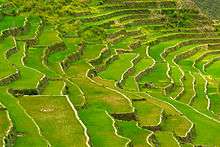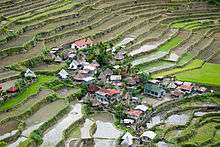Rice Terraces of the Philippine Cordilleras
| Rice Terraces of the Philippine Cordilleras | |
|---|---|
| Name as inscribed on the World Heritage List | |
|
Batad Rice Terraces, Ifugao Province, Philippines. | |
| Type | Cultural |
| Criteria | III, IV, V |
| Reference | 722 |
| UNESCO region | Asia-Pacific |
| Inscription history | |
| Inscription | 1995 (19th Session) |
| Endangered | 2001–2012 |




The Rice Terraces of the Philippine Cordilleras (Filipino: Mga Hagdan-Hagdang Palayan ng Kordilyera ng Pilipinas) were inscribed on the UNESCO World Heritage List in 1995, the first-ever property to be included in the cultural landscape category of the World Heritage List.[1] This inscription has five sites: the Batad Rice Terraces, Bangaan Rice Terraces (both in Banaue), Mayoyao Rice Terraces (in Mayoyao), Hungduan Rice Terraces (in Hungduan) and Nagacadan Rice Terraces (in Kiangan), all in the Ifugao Province, the Philippines. The Ifugao Rice Terraces reach a higher altitude and were built on steeper slopes than many other terraces. The Ifugao complex of stone or mud walls and the careful carving of the natural contours of hills and mountains to make terraced pond fields, coupled with the development of intricate irrigation systems, harvesting water from the forests of the mountain tops, and an elaborate farming system.
The Ifugao Rice Terraces illustrate the remarkable ability of human culture to adapt to new social and climate pressures as well as to implement and develop new ideas and technologies. Although listed by the UNESCO as a World Heritage site believed to be older than 2,000 years, there are some conflicting studies that report they may be less than 1,000 years old.
Maintenance of the living rice terraces reflects a primarily cooperative approach of the whole community which is based on detailed knowledge of the rich diversity of biological resources existing in the Ifugao agro-ecosystem, a finely tuned annual system respecting lunar cycles, zoning and planning, extensive soil conservation, and mastery of a complex pest control regime based on the processing of a variety of herbs, accompanied by religious rituals.
Historical description
The rice terraces of the Cordilleras are one of the few monuments in the Philippines that show no evidence of having been influenced by colonial cultures. Owing to the difficult terrain, the Cordillera tribes are among the few peoples of the Philippines who have successfully resisted any foreign domination and have preserved their authentic tribal culture. The history of the terraces is intertwined with that of its people, their culture, and their traditional practices.[2]
Apart from the idjang stone-fortresses of the Ivatan of the Batanes, the terraces, which spread over five present-day provinces, are the only other only form of surviving stone construction from the pre-colonial period. The Philippines alone among south-east Asian cultures is a largely wood-based one: unlike Cambodia, Indonesia, or Thailand, for example, in the Philippines both domestic buildings and ritual structures such as temples and shrines were all built in wood, a tradition that has survived in the terrace hamlets.[2]
It is believed that terracing began in the Cordilleras less than one thousand years ago as Taro cultivation. It is evidence of a high level of knowledge of structural and hydraulic engineering on the part of the Ifugao builders. The knowledge and practices, supported by rituals, involved in maintaining the terraces are transferred orally from generation to generation, without written records. Taro was later replaced by rice around 1600 A.D. which is the predominant crop today.[2]
National Cultural Treasures
The five clusters inscribed as part of the Rice Terraces of the Philippine Cordilleras are Batad, Bangaan, Hungduan, Mayoyao Central and Nagacadan.[3] Batad and Bangaan are under the jurisdiction of the Municipality of Banaue but are not referred to as the Banaue Rice Terraces.
The Banaue Rice Terraces refer to the cluster close to the Banaue poblacion as seen from the viewpoint. Contrary to popular belief, these terraces are not part of the UNESCO World Heritage Site. They were not included in the UNESCO inscription due to the presence of numerous modern structures, making it score low in the integrity criterion of UNESCO. The Banaue Rice Terraces are however a National Cultural Treasure under Ifugao Rice Terraces, together with the other rice terraces clusters.
A designated Globally Important Agricultural Heritage Site
For more information on the Ifugao Rice Terraces as part of the Globally Important Agricultural Heritage Systems, see: GIAHS
All located in the Ifugao region, the Rice Terraces also feature as one of the Globally Important Agricultural Heritage Sites or GIAHS. They are supported by indigenous knowledge management of muyong, a private forest that caps each terrace cluster. The muyong is managed through a collective effort and under traditional tribal practices. The communally managed forestry area on top of the terraces contains about 264 indigenous plant species, mostly endemic to the region. The terraces form unique clusters of microwatersheds and are part of the whole mountain ecology. They serve as a rainwater filtration system and are saturated with irrigation water all year round. A biorhythm technology, in which cultural activities are harmonized with the rhythm of climate and hydrology management, has enabled farmers to grow rice at over 1 000 meters.
The Ifugao epic Hudhud
Aside from the Rice Terraces of the Philippine Cordilleras, UNESCO inscribed the Hudhud Chants of the Ifugao,[4] another National Cultural Treasure, on the Representative List of the Intangible Cultural Heritage of Humanity in 2008 (originally proclaimed in 2001). The Hudhud consists of narrative chants performed mainly by elder Ifugao women usually during the rice sowing season, at harvest time and at funeral wakes and rituals.
Preservation
The Rice Terraces of the Philippine Cordilleras were named as a World Heritage Site[5][6][7] by the UNESCO World Heritage Centre in 1995. It has passed by UNESCO’s standards[8] due to the blending of the physical, socio-cultural, economic, religious, and political environment as a living cultural landscape.
The Ifugao Rice Terraces[9] have also been inscribed in the List of World Heritage in Danger in 2001 as the dangers of deforestation and climate change threatens to destroy the terraces. Another contributing factor is globalization where the younger generations of the Ifugaos have recently had the opportunity to gain access to media and education, most of the younger Ifugaos[10] have opted to come to the capital for work instead of the traditional farming tradition. The Philippines sought danger listing as a way to raise national and international support and cooperation in the preservation of the heritage site.[11]
In 2012, UNESCO has removed the Rice Terraces from the list of sites in danger in recognition of the success of the Philippines in improving its conservation.[11][12]
See also
References
- ↑ Malig, Jojo (26 June 2012). "Philippine rice terraces no longer in danger". ABS-CBN News. Retrieved 26 June 2012.
- 1 2 3 Advisory Body Evaluation, World Heritage. "Rice Terraces of the Philippine Cordilleras". © UNESCO World Heritage Centre. Retrieved 26 June 2012.
- ↑ "UNESCO World Heritage Centre". UNESCO. Retrieved 2011-01-01.
- ↑ "The Hudhud Chants of the Ifugao". UNESCO. Retrieved 2011-01-01.
- ↑ "World Heritage List". UNESCO. Retrieved 2009-07-15.
- ↑ "Earth Day, Part 3: Banaue Rice Terraces". World Press. Retrieved 2009-07-15.
- ↑ "Preserving the Ifugao Heritage". Philippine Daily Inquirer. Retrieved 2009-07-17.
- ↑ "Criterion - Passed". UNESCO. Retrieved 2009-07-15.
- ↑ "Heritage sites in danger". UNESCO. Retrieved 2009-07-15.
- ↑ "The Probe Team", ABS CBN
- 1 2 "Better conservation in Pakistan and the Philippines allow Committee to remove two sites from World Heritage List in Danger". UNESCO. 2012-06-27. Retrieved 2012-06-28.
- ↑ "Philippines rice terraces off endangered list–UN". Inquirer.net. June 28, 2012. Retrieved June 27, 2012.
External links
| Wikimedia Commons has media related to Rice terraces in the Philippines. |
